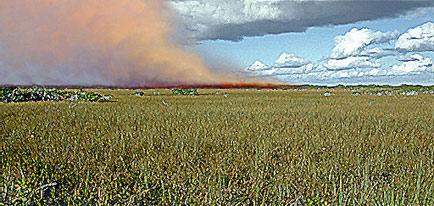Fires in Florida’s Everglades

Fire is critical to the survival of the pineland and prairie ecosystems of the Everglades. Located on the extreme southern section of the Florida peninsula, the Everglades ecosystem is unique. Fires perpetuate the river of grass and for 10’s of thousands of years lightning strikes have ignited fires in the sawgrass prairies. Sawgrass fires actually improve the passage of water through the slough or shallow river basin, by burning back grass that would otherwise impede the vital flow of water through the Everglades. Fire not only improves habitat for wildlife by creating a mosaic pattern of vegetation, but also helps reduce large accumulation of fuels near hammocks or tree islands, which harbor a wide variety of subtropical plants less tolerant of fire.
This region encompasses sawgrass marshes, hardwood hammocks, mangrove swamps, lakes, and coastal waters and is known for its abundant animal life including alligators, the largest concentration of wading birds on the American continent, and is home to 14 threatened or endangered species. The park preserves one of the world’s truly unique ecosystems. Some of the world’s rarest orchids grow and thrive here, flowering in the wild.
As well, over forty species of mammals inhabit Everglades National Park. Though they often utilize drier habitats, many are also adapted to the semi-aquatic habitats of the Everglades and it is not uncommon to see white-tailed deer wading through the sawgrass prairies.


